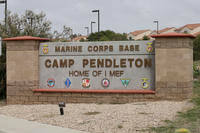PRESIDIO OF MONTEREY, Calif. -- A Defense Language Institute Foreign Language Center student here was recognized Oct. 17 with the Distinguished Flying Cross for his heroic actions in Afghanistan in December 2012.
Capt. Charles C. Napier is credited for saving the lives of three critically-wounded Soldiers in an Afghan village west of Kandahar by skillfully maneuvering his rescue helicopter and placing it between enemy and friendly forces thereby blocking close-range, intense small-arms fire.
“It was an honor to award Captain Napier the Distinguished Flying Cross with Valor during our Air Force Wingman Day,” said Col. Ginger Wallace, the commander of the Air Force 517th Training Group and assistant commandant of DLIFLC, referring to the afternoon long event that promotes peer support, team building and resiliency.
“It was very fitting to begin the event by recognizing an Airman who demonstrated tremendous courage to protect his aircraft and successfully rescue coalition Soldiers while facing enemy fire,” she explained, to the applause of hundreds of Airmen.
Aside from the Distinguished Flying Cross with valor, Napier received the Air Force Combat Action Medal, and his 16th Air Medal.
Napier graciously accepted his awards, but insisted he was only doing his job.
“This was a total surprise. I would not have expected this (recognition) in my wildest dreams. I am really humbled,” Napier said, adding that “the success of the mission is a result of team work. I couldn’t have done it without my crew members.”
In an interview, Napier divulged some of the details about the complexity of the mission and the real danger that faced the two HH-60G Pave Hawk Air Force rescue helicopters and two Army OH-58 Kiowa scout helicopters that came under a rocket-propelled grenade attack.
“We were able to identify the enemy position after the RPGs were fired at the lead HH-60 aircraft,” Napier explained. “We made several weapons patterns and the final one was used to mark the enemy with our rounds in order for the Kiowas to identify the enemy position.”
A lull in fighting ensued after the Kiowas aggressively engaged the enemy with machine guns and rockets, allowing the first aircraft to land and offload three pararescuemen.
“My aircraft went first and we took some fire while on the ground. As I lifted, my gunner fired back. Next, (another rescue helicopter) landed and we protected them with suppressive fire while they were loading,” he explained.
Napier’s repeatedly skillful maneuvering of his aircraft into firing position just 60 feet away from the enemy, shielding friendly forces from enemy fire, essentially saved the lives of the men on the ground that day.
“Once the (pararescuemen) packaged up the wounded and all were on board, we returned to base,” he said.
“It was just like any other day,” he said. “That is what we are trained to do. We help people who are in harm’s way
Napier is currently attending an intensive French course at DLIFLC, which is the Department of Defense’s premier foreign language provider. After graduation he expects to be stationed in the French region of Bordeaux as an exchange pilot to fly search and rescue helicopters with his French counterparts.




























